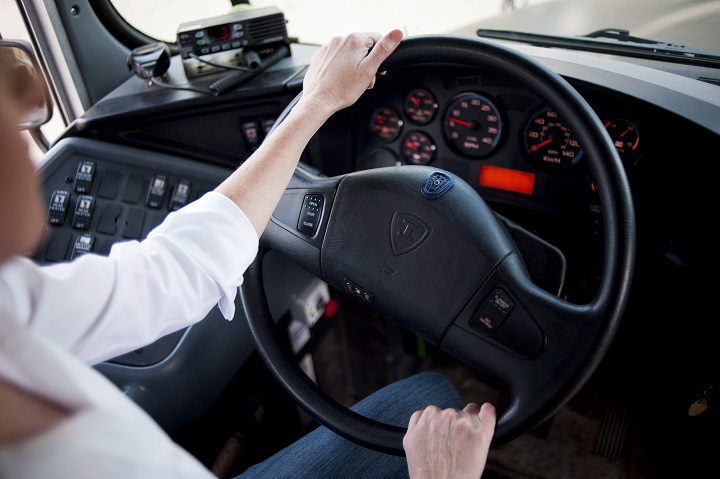Maybe you have more wrinkles and sun spots on the left side of your face – or a farmer’s tan gives away how much time you spend in your car.

A new study is warning that while your front windshield may be protecting you from some of the sun’s UVA rays as you drive, your side windows aren’t offering the same coverage at all. This is putting drivers at an increased risk of skin cancer and cataracts if they aren’t protecting themselves adequately.
The study’s lead author says his findings have major implications for all walks of life: those with occupations that rely heavily on driving, to everyday Canadians who drive to work and families with babies and kids in the backseat.
“The gravity of this study, the ripple effect is massive because there are millions and millions of people who drive their cars to work, there’s vacations and road trips coming up this summer,” Dr. Brian Boxer Wachler told Global News.
“My hope is that automakers that spend and invest so much for safety of drivers with airbags and other aspects will look into this other way to improve safety for drivers,” he said.
Boxer Wachler is a Beverley Hills-based ophthalmologist specializing in helping patients with cataracts, or who need vision correction.
Boxer Wachler says he was tending to a patient with a corneal eye disease when he noticed she had more age spots and sun spots on the left side of her face. After that he noticed the pattern in more of his patients.
READ MORE: What you need to know about sunscreen and protecting your skin
“I did research and found a number of studies in dermatology that found more skin cancer on the left side of the body and face and more cataracts on the left side,” he told Global News. The research also pointed to the trend in Australia, where driving is on the opposite side of the road. In those cases, there were more cases on the right side of the body.

Get weekly health news
For his research, Boxer Wachler wanted to know how much protection car windows and the windshield provide against ultraviolet rays.
There are three spectrums of light – ultraviolent A (long rays) is tied to aging the skin, ultraviolet B (short rays) can lead to burns and ultraviolet C isn’t as worrisome because most of the rays are absorbed by the ozone layer.
UVA, which Boxer Wachler zeroed in on, can contribute to cataract formation, skin cancer and skin damage. In the study, he identified 29 car models from 15 major auto manufacturers, including Toyota, General Motors, Honda, Mercedes Benz, and BMW.
READ MORE: Is aerosol sunscreen safe for you? Inhaling chemicals is a concern
Armed with a meter that measures UVA light, Boxer Wachler went to a Los Angeles dealership and recorded how much protection consumers would get from the side window and the windshield in the various cars.
Turns out, windshields blocked about 96 per cent of UVA, while the average for side windows was about 71 per cent. Only four car models met the 90 per cent target for side window coverage.
“I found that the windshield has extremely good levels of UV protection on cars, but side windows are actually very low and variable for protection. Even cars that had factory tinted windows had no guarantee there would be full UV protection. This is a big wake up call,” he told Global News.
Dr. Anatoli Freiman, a dermatologist and medical director of the Toronto Dermatology Centre, says that Canadians need to protect themselves from sun damage, even from the comfort of their cars.
READ MORE: Here’s how much you’ll lower your skin cancer risk by applying sunscreen
“Dermatologists surely know this and have known this for a long time. We see more skin cancers on the left side, and it’s classic that truck drivers get more sun damage, aging and wrinkles on the left side from years of sun exposure,” Freiman told Global News.
There are some precautionary measures you can take:
- Put on your sunscreen. While you may be applying sunscreen 20 minutes before arriving at the beach or heading out of your car, apply it before you get into your car instead. The study suggests sun damage can occur during the car ride, so make sure you’re protected during long road trips, for example.
- Dress appropriately. Wear sun-protective clothing and sunglasses to protect your eyes. A wide-brimmed hat can protect your face and neck from sun exposure.
- Cover the backseat side windows. You can stick blinds to the sides of your car to protect your kids and babies from the sun during long drives. Skin damage is cumulative so any measures you put into place now will help your growing children in the long run, Freiman says. An after-market film can be applied to your side windows, too.
As of Tuesday afternoon, Toyota, General Motors, Honda and BMW did not respond to a request for comment on the study.
Mercedes-Benz says its UV protection is “very good,” according to measurements made by an independent institute in 2015.
“We are currently reviewing whether it makes sense to incorporate additional UV protection into ESG (tempered safety glass) by using a different glass composition or coating,” a spokesperson said in an email.
Boxer Wachler’s full findings were published in the journal JAMA Ophthalmology.
carmen.chai@globalnews.ca
Follow @Carmen_Chai







Comments